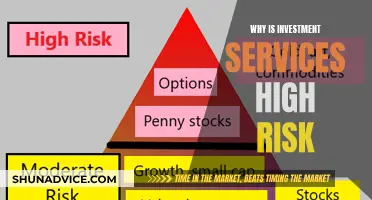
Risk is the possibility that a negative financial outcome will occur. When it comes to investing, risk is the chance that you will lose money. The level of risk associated with a particular investment or asset class typically correlates with the level of return the investment might achieve. This is known as the risk-reward relationship. Understanding the level of risk you need and want is a very important part of selecting a good investment strategy.
| Characteristics | Values |
|---|---|
| Risk | The possibility that a negative financial outcome will occur |
| Return | The higher the risk, the higher the possible return |
| Time horizon | The amount of time you expect to invest for, e.g. a 25-year-old saving for retirement can afford to take on more risk as they have a long time horizon |
| Investor type | Conservative, moderate, aggressive |
What You'll Learn

Risk-reward
The rationale behind this relationship is that investors willing to take on risky investments and potentially lose money should be rewarded for their risk. An investor with a moderate risk tolerance, for example, might balance risk and return by emphasising stocks while also allocating a significant amount to bonds, government securities and cash equivalents. On the other hand, an aggressive investor may be more willing to take on higher risks for potentially higher returns and might therefore focus on stocks, including non-US companies, with a smaller allocation to bonds and government securities.
Determining the level of risk and reward needed is a key aspect of choosing an investment strategy. Time horizon is an important factor here: a 25-year-old saving for retirement can afford to go for much riskier investments since, if they lose their money, they still have a few decades to be able to make it back.
It's important to understand the level of risk you need and want when selecting an investment strategy.
REIT Investment: A Guide to India's Real Estate Investment Trusts
You may want to see also

Time horizon
The time horizon of an investment is a key consideration when determining the appropriate risk level. This involves thinking about when you expect to use the money you are investing. For example, a 25-year-old saving for retirement can afford to take on much riskier investments, as they have several decades to make their money back if they lose it.
Risk is the possibility of a negative financial outcome. The level of risk associated with an investment typically correlates with the level of return that investment might achieve. Investors who take on riskier investments and potentially lose money should be rewarded for their risk.
There are several types of investors, categorised by their risk tolerance. Conservative investors tend to seek steady returns while maintaining a lower level of risk. They may emphasise bonds, government securities and cash equivalents. Moderate-risk investors balance risk and return, investing in stocks, bonds, and government securities. Aggressive investors are willing to take on higher risks for potentially higher returns, focusing on stocks, including non-US companies.
The investment risk pyramid is an asset allocation strategy that places low-risk assets like cash and treasuries at the bottom and smaller allocations to riskier assets like growth stocks at the top.
Exploring Careers in Investment Management: Diverse Opportunities
You may want to see also

Conservative, moderate, and aggressive investors
Risk is the possibility that a negative financial outcome might occur. The level of risk associated with a particular investment or asset class typically correlates with the level of return the investment might achieve. The rationale behind this relationship is that investors willing to take on risky investments and potentially lose money should be rewarded for their risk.
Conservative investors tend to seek steady returns while maintaining a lower level of risk. They may want to emphasise stocks, combined with a significant allocation to bonds, government securities and cash equivalents.
Moderate investors want to balance risk and return. They may also emphasise stocks, but with a smaller allocation to bonds and government securities.
Aggressive investors are willing to take on higher risks for potentially higher returns. Their primary focus is on stocks, including non-US companies, to potentially achieve growth with a smaller allocation to bonds and government securities.
Your time horizon will also play a role in determining your risk level. For example, a 25-year-old saving for retirement can afford to take on much riskier investments since, if they lose their money, they still have a few decades to make it back.
Investment Manager Certifications: Essential Credentials for Success
You may want to see also

Investment risk pyramid
Risk is the possibility that a negative financial outcome that matters to you might occur. The level of risk associated with a particular investment or asset class typically correlates with the level of return the investment might achieve. In other words, the higher the risk, the higher the possible return.
The investment risk pyramid is an asset allocation strategy. At the bottom of the pyramid are low-risk assets like cash and treasuries. At the top are smaller allocations to riskier assets like growth stocks.
Determining the level of risk and reward needed is a key aspect of determining an investment strategy. For example, a 25-year-old saving for retirement can go for much riskier investments since if they lose their money in a bear market, they still have a few decades to be able to make their money back.
With a moderate risk tolerance, balancing risk and return is likely most important. An emphasis on stocks, combined with a significant allocation to bonds, government securities and cash equivalents may help achieve the balance between taking risks and growing a portfolio.
Moderate Risk Investments: How Much Can You Expect?
You may want to see also

Understanding risk
Risk is the possibility of a negative financial outcome. The level of risk associated with an investment typically correlates with the level of return the investment might achieve. The rationale behind this relationship is that investors willing to take on riskier investments and potentially lose money should be rewarded for their risk.
Determining the level of risk and reward needed is a key aspect of determining an investment strategy. Your time horizon will involve when you expect to use the money you are investing. For example, a 25-year-old saving for retirement can afford to take on much riskier investments since, if they lose their money, they still have a few decades to be able to make it back.
The investment risk pyramid is an asset allocation strategy whereby low-risk assets like cash and treasuries are placed at the bottom, and smaller allocations to riskier assets like growth stocks are placed at the top. With a moderate risk tolerance, balancing risk and return is likely most important. An emphasis on stocks, combined with a significant allocation to bonds, government securities and cash equivalents may help achieve the balance between taking risks and growing a portfolio.
With a higher risk tolerance, an aggressive investor may be more willing to take on higher risks for potentially higher returns. Their primary focus may be on stocks, including non-U.S. companies, to potentially achieve growth with a smaller allocation to bonds and government securities.
Unlocking Private Equity: Rewards and Risks for Investors
You may want to see also
Frequently asked questions
Investment risk level refers to the possibility that a negative financial outcome will occur. The level of risk associated with an investment typically correlates with the level of return the investment might achieve.
Determining your investment risk level involves understanding the level of risk and reward you need and want. This will depend on factors such as your time horizon (when you expect to use the money you are investing) and your risk tolerance.
Your investment risk level will influence the types of investments you choose and how you allocate your assets. For example, a conservative investor seeking steady returns with a lower level of risk may emphasise stocks, bonds, government securities and cash equivalents. On the other hand, an aggressive investor with a higher risk tolerance may focus more on stocks, including those of non-US companies, to achieve potentially higher returns.







